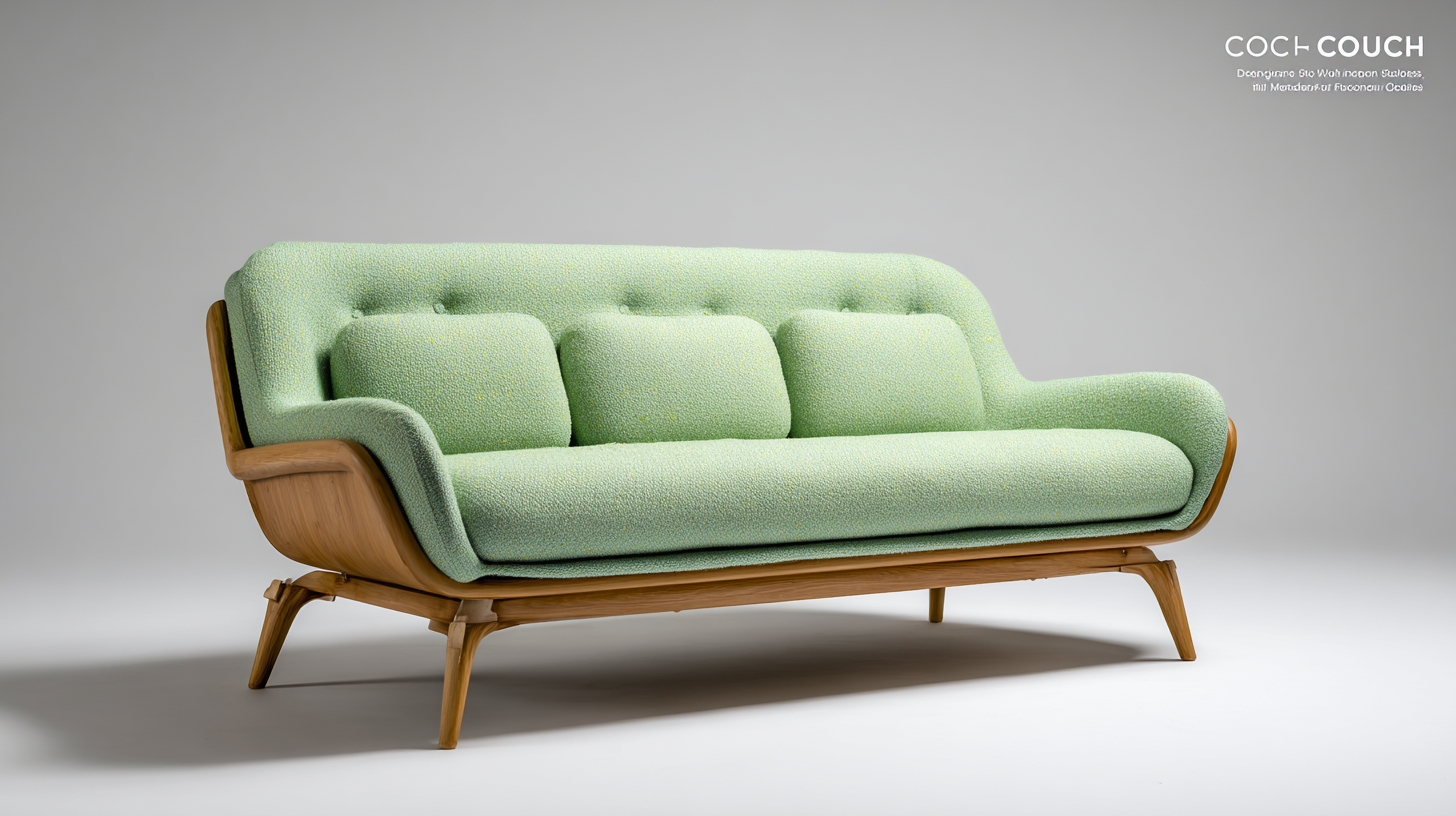As the global furniture market is projected to reach a staggering $650 billion by 2025, the demand for innovative and aesthetic designs has never been greater. Among the most sought-after furniture pieces is the "Design Couch", which not only serves as a functional seating solution but also embodies a blend of style and technology. According to a recent report by the International Furniture and Interior Design Association, the rise of smart homes and customizable living spaces is driving a shift towards more personalized furniture options. The Design Couch stands at the forefront of this trend, offering features that cater to individual tastes while enhancing the overall living experience. As consumers increasingly prioritize sustainability and mindfulness in their purchases, the Design Couch will play a pivotal role in transforming the global furniture market by marrying practical functionality with sleek design, ultimately reshaping how we view and utilize our indoor spaces.

As we look ahead to 2025, the landscape of couch designs is set to experience a seismic shift, positioning itself at the forefront of global furniture trends. With a strong inclination towards maximalism, designers are advocating for rich fabrics and earthy tones, combined with bold patterns that reflect personal expression and comfort. The latest insights reveal that bespoke upholstery is also gaining prominence, allowing consumers to customize their couches to fit unique home aesthetics perfectly.

Tips for Choosing the Right Couch:
- Embrace Textures: Opt for diverse materials such as velvet, linen, or leather to add depth and warmth to your living space.
- Think Modular: Modular couches offer flexibility for various room layouts, catering to different styles and functionality needs.
- Sustainability Matters: Consider eco-friendly options that utilize sustainable materials, appealing to the growing trend of environmentally conscious consumerism.
According to a recent report, the contract furniture market is predicted to reach USD 167.7 billion by 2025, underscoring an increasing demand for innovative and stylish furniture solutions. With a focus on aesthetic appeal and practicality, the couch of 2025 will not only serve as a centerpiece in living rooms but also embody the evolving tastes and values of modern consumers.
The furniture industry is on the brink of a transformation driven by the increasing demand for sustainable materials in couch manufacturing. According to a report by Grand View Research, the global sustainable furniture market is projected to reach $80 billion by 2025, expanding at a compound annual growth rate (CAGR) of 9.7%. This growing segment highlights a profound shift in consumer preferences, with more buyers prioritizing eco-friendly materials over traditional options. As the industry pivots towards sustainability, manufacturers are exploring innovative materials such as recycled plastics, reclaimed wood, and organic textiles.

Moreover, a study conducted by Furniture Today indicates that 60% of consumers are willing to pay a premium for furniture made from sustainable materials. This willingness directly influences design trends, as manufacturers strive to meet the evolving expectations of eco-conscious consumers. Companies like IKEA and West Elm are already leading the charge by incorporating sustainable sourcing into their production processes, including the use of water-based adhesives and low-VOC finishes. By 2025, the integration of sustainable materials will not only enhance product appeal but will also redefine the competitive landscape of the global furniture market, positioning sustainability at the heart of design innovation.
As we delve into the evolving landscape of furniture design, consumer preferences are shifting towards a harmonious blend of comfort, style, and functionality. In an era where home is increasingly becoming an extension of personal identity, the best design couch embodies these essential attributes. Designers are now faced with the challenge of creating pieces that not only act as statement furniture but also provide an inviting space for relaxation and connection.
The drive for comfort has become paramount, as consumers seek furniture that supports their lifestyles. With more time spent at home, the demand for ergonomic design and cozy aesthetics is on the rise. Coupled with sleek lines and modern materials, today's couches are not just designed for lounging but are being crafted to enhance the overall ambiance of the living space, making comfort a key selling point. Style, meanwhile, continues to play a crucial role; from minimalist designs to bold colors, the variety is vast, catering to diverse tastes. The fusion of functionality is also noteworthy, with multifunctional pieces that adapt to small living spaces or offer additional storage solutions. Such innovations are set to redefine the furniture market, steering it towards a future where consumer satisfaction is paramount.
As we approach 2025, the furniture market is poised for a significant transformation driven by technology, particularly in couch design and production. Innovations such as 3D printing and advanced materials are making it possible to create custom designs that cater to the diverse tastes and needs of consumers. Gone are the days of one-size-fits-all furniture. With sophisticated design software, manufacturers can now visualize and modify designs in real time, leading to more personalized and functional pieces that resonate with modern lifestyles.
Moreover, smart technology is infiltrating our living spaces, with couches now equipped with features like built-in charging stations, adjustable seating positions, and even integrated entertainment systems. These advancements not only enhance comfort but also integrate seamlessly with the tech-savvy households of today. As consumers increasingly seek out multifunctional furniture that complements their high-tech lives, the role of technology in revolutionizing couch design will be more crucial than ever. This evolution reflects a broader shift within the furniture industry, where convenience, personalization, and innovation take center stage.
| Category | Current Trends | Projected Innovations (by 2025) | Impact of Technology |
|---|---|---|---|
| Material Usage | Sustainable materials, like recycled fabrics | Smart textiles that adapt to body temperature | AI-assisted material selection |
| Design Customization | Limited customization options available | Fully customizable designs through online platforms | Augmented reality for visualization |
| Production Techniques | Traditional manufacturing processes | 3D printing for complex designs | Automation and robotics in assembly |
| Consumer Interaction | In-store experience favored | Virtual showrooms and interactive websites | AI for personalized shopping experience |
China is rapidly emerging as a pivotal force in shaping future furniture trends, particularly in the domain of innovative design and advanced manufacturing. With its expanding capabilities in research and development, Chinese manufacturers are set to revolutionize the global furniture market by 2025, introducing cutting-edge designs that prioritize sustainability and technology integration. This innovation wave is expected to influence global consumer preferences, as eco-friendly materials and smart furniture become increasingly desirable.
**Tips for Embracing Chinese Furniture Trends:**
1. **Focus on Sustainability:** As China leads the charge in eco-conscious design, consider sourcing furniture that incorporates sustainable materials and production methods. This not only aligns with global trends but also appeals to environmentally aware consumers.
2. **Incorporate Smart Technology:** With the rise of smart furniture, think about how technology can enhance the functionality of your pieces. Whether it’s integrated charging ports or adjustable features, these elements can make your offerings more appealing.
3. **Stay Informed About Market Dynamics:** Regularly review market reports and analyses to stay ahead of emerging trends. Understanding the evolving dynamics of the furniture market will enable you to adapt and position your brand effectively in this competitive landscape.
As China's influence grows, it’s essential for businesses to leverage these insights to remain relevant in the ever-changing global furniture arena.
